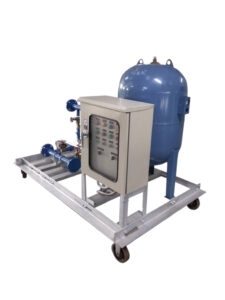PRESSURE TANK
(PRESSURE TANK )
also known as a pressure vessel or pressure accumulator, is an essential component in many water supply systems, particularly those utilizing well pumps or booster pump systems. It plays a crucial role in maintaining consistent water pressure and reducing the frequency of pump cycling. Here are the key features and functions of a pressure tank:
- Storage of Pressurized Water
The primary function of a pressure tank is to store water under pressure. When the pump operates, it fills the tank, pressurizing the air within the tank.
- Air Chamber
Pressure tanks are equipped with an air chamber separated from the water by a rubber diaphragm or bladder. The air chamber provides a cushion against pressure variations, allowing for smoother and more controlled water flow.
- Preventing Rapid Pump Cycling
The pressure tank helps prevent rapid cycling of the pump. Instead of the pump turning on and off frequently in response to small changes in water demand, the tank supplies water to the system during short periods of low demand.
- Maintaining Consistent Pressure
As water is drawn from the system, the pressure tank releases water from the pressurized air chamber, maintaining a relatively constant water pressure in the distribution system.
- Pressure Switch Control
The pressure tank is typically connected to a pressure switch. When the pressure in the tank drops below a certain threshold, the pressure switch signals the pump to start, refilling the tank.
- Adjustable Air Precharge
Pressure tanks often have an adjustable air precharge. This precharge pressure is set to ensure that the pump starts at an appropriate pressure level, optimizing the tank’s performance.
- Diaphragm or Bladder Design
Traditional pressure tanks use a diaphragm to separate the air and water. More modern tanks may have a replaceable bladder. Both designs prevent water from coming into direct contact with the inside of the tank, reducing the risk of corrosion.
- Materials of Construction
Pressure tanks are typically constructed from materials that are resistant to corrosion, such as steel, stainless steel, or composite materials. The choice of material depends on the specific requirements of the application and the type of water being handled.
- Various Sizes and Capacities
Pressure tanks are available in different sizes and capacities to accommodate the needs of various applications, from residential water supply to industrial processes.
Pressure tanks are integral to maintaining a stable and efficient water supply in systems where water pressure fluctuations are common. They are commonly used in residential well water systems, booster pump systems, and other applications where maintaining a consistent pressure is essential. The correct sizing and installation of a pressure tank are crucial for optimal performance in a water supply system.
Bootster Pump


